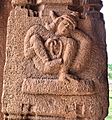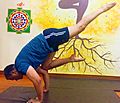Asana facts for kids
Asana is a special body position used in Yoga. It can mean the way a person sits, or even the place they sit. Asanas help to bring balance to your mind and body. They are meant to be steady and strong, but also comfortable.
All the many different body positions in Yoga are called Asanas. Each one has its own name, and almost all of them end with asana. For example, savasana means "correct lying" and bujangasana means "cobra" (like the snake). Other names describe the position, such as shirshasana, which means "head" (for a headstand).
Images for kids
-
Asanas in varied contexts. Left to right, top to bottom: Eka Pada Chakrasana; Ardha Matsyendrasana; Padmasana; Navasana; Pincha Mayurasana; Dhanurasana; Natarajasana; Vrkshasana
-
Mould of Pashupati seal from the Indus Valley civilization, c. 2500 BC, its central figure in a pose resembling Mulabandhasana.
-
A page from Patanjali's Yoga Sutras and Bhasya commentary (c. 2nd to 4th century CE), which placed asana as one of the eight limbs of classical yoga
-
Relief statue in Achyutaraya temple, Hampi, Karnataka showing an unidentified hand-balancing asana, 16th century
-
"Seal" posture from Mary Bagot Stack's Building the Body Beautiful, 1931. It closely resembles Salabhasana, locust pose; she had learnt some asanas in India in 1912.
-
The Indian Minister for Women and Child Development, Maneka Gandhi, joining a programme of yoga for pregnant women in 2018
-
Jambhala, the Buddhist god of riches, seated in Lalitasana. Nepal, 1643
See also
 In Spanish: Asana para niños
In Spanish: Asana para niños












